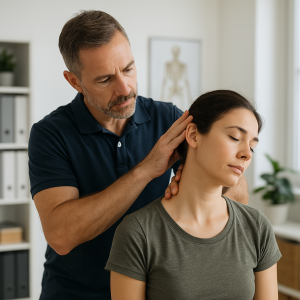If you’re dealing with a severe whiplash, you’ve probably already heard dozens of treatment suggestions, from physio to acupuncture to chiropractors. And if you’re like me, you’re not just looking for pain relief. You want to actually feel better.
In this article, I’ll share the treatments I personally tried, what they did (or didn’t) do for me, and my honest take on each one. Just keep in mind: everyone is different. What didn’t work for me might be a game changer for you, and that’s okay. This is just my experience.
Chiropractor
What is it?
Chiropractors focus on aligning your spine and joints, often using manual adjustments or “cracks” to improve function and reduce pain.
My experience
At first, it felt like it helped. Maybe it was placebo, or maybe just the relief of finally doing something after weeks of pain and frustration. There’s definitely value in having someone assess your whole body and approach the issue from a more holistic point of view, which is something many chiropractors do well. They don’t just look at the injury in isolation, but at how the whole spine and posture may be contributing to your symptoms.
That said, the adjustments never really had a lasting effect for me. I’d feel a slight release or improvement right after a session, but within a few hours, things felt the same. Over time, I started to feel like I was just chasing temporary relief rather than actually improving.
Still, I know people who’ve had amazing results with chiropractic care, especially those with mechanical or alignment-based issues. It didn’t do much for me personally, but it might be helpful for you. Especially if you find a chiropractor who really listens and looks at the bigger picture.

MSK Doctor (Musculoskeletal Specialist)
What is it?
An MSK doctor diagnoses and treats issues related to bones, joints, and soft tissues. Think of it as a specialist somewhere between a physio and an orthopedic doctor.
My experience
This was recommended by my sports doctor, so I went in hopeful. The MSK specialist was very thorough. She carefully examined my posture, movement, and spine, and even noted down every detail. From slight scoliosis to a few vertebrae in my neck that were misaligned. She explained everything clearly, which I appreciated.
The treatment involved a lot of manual adjustments, joint manipulation, and even some realignment work on my hips. While it sometimes felt like things shifted into place, that feeling never lasted. Within an hour or so, my body felt like it had returned to its usual discomfort. It was also a pretty expensive process for results that, in my case, didn’t stick.
That said, I know people who’ve found this kind of care really helpful, especially when structural issues are a big part of the problem. For me, it just didn’t lead to lasting progress.

Acupuncture
What is it?
An ancient Chinese practice that uses fine needles in specific points of the body to release tension, increase energy flow, and promote healing.
My experience
I went to a Brazilian practitioner who combined acupuncture with massage, meditation, and a very calm, grounded presence. From the first session, what stood out most was that she really listened. She wasn’t rushing to treat a symptom or push one specific method. She took time to understand how I was feeling, both physically and mentally.
That alone made a difference. Being heard and treated as a whole person, not just a sore neck, created a space where I felt more relaxed and more open to healing. The acupuncture and massage she did brought real, noticeable relief. My neck loosened up, tension melted a bit, and even if the results didn’t last forever, it gave me breathing room.
I wouldn’t call it a miracle fix, but it became a valuable part of my recovery process, especially when paired with stretching and strength training. I still go back occasionally when I feel tension building. Not because I expect to be cured, but because it feels like giving my body a reset.

Physiotherapy
What is it?
A clinical approach to improving movement, reducing pain, and strengthening muscles usually through exercises and manual therapy.
My experience
This helped me more than anything else.
My physiotherapist didn’t just treat the pain he helped me understand how my body was reacting after the injury. We focused on rebuilding trust in movement and slowly strengthening the muscles that support my neck and spine.
Instead of jumping into intense rehab, he gave me simple, clear exercises that felt safe and doable. He also talked about how stress and trauma can affect the nervous system and how tension might be linked to more than just posture or mechanics.
The Practitioner Matters More Than the Title
One thing I’ve learned: the person treating you matters more than their job title. I’ve had official doctors who looked only at scans and didn’t listen. And I’ve had holistic practitioners who saw the whole picture, physical, mental, emotional and helped me move forward.
Find someone who listens. Someone who sees the full picture, more than just the part of the body they’re trained to treat. That makes a huge difference.
Final Thoughts
Different things work for different people. This was my journey, some things helped, some didn’t. You’ll have to explore and figure out what fits your body best.
But the truth is, the biggest progress came not from treatments, but from me. Stretching daily. Strengthening consistently. Calming my nervous system. That’s where things started to shift.
You don’t need to chase every expensive option. Just start small, stay consistent, and trust that your body can recover.
Looking for a place to start?
Try my simple Daily Neck Stretch Routine or explore the strengthening exercises.
Further Reading
